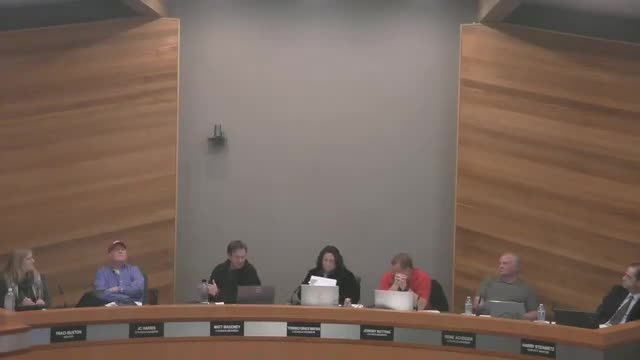Council hears estuary alternatives as staff balances habitat restoration and flood protection
January 11, 2025 | Des Moines City, King County, Washington
This article was created by AI summarizing key points discussed. AI makes mistakes, so for full details and context, please refer to the video of the full meeting. Please report any errors so we can fix them. Report an error »

City surface‑water staff and consultants presented the Des Moines Creek Estuary project to the City Council on Jan. 9, showing conceptual alternatives that weigh salmon habitat restoration, beach access and rising sea‑level flood risk.
What was presented
- Staff identified goals of salmon recovery (regional watershed plans), flood protection as sea levels rise, and enhancement of pedestrian beach access and park amenities. The project would modify the creek mouth, remove hard riprap in places, expand intertidal marsh and raise portions of the beach‑park meadow to add resilience.
- Consultants reported sea‑level inundation modeling through year 21100 that shows increasing frequency of tidal inundation on the beach park; some of the modeled levels correspond to recent King‑Tide events observed in late 2024.
- A “maximum benefit” alternative would widen the creek mouth, remove armoring, install near‑shore plantings and create gravel/sandy beach access with intertidal marsh; the proposal would relocate a pedestrian bridge upstream and accommodate the historic meadow boundary.
Questions and concerns
Council members asked whether vehicle access easements for private shoreline homes would be affected (the easements remain in place under current assumptions); whether soft‑armoring options would need periodic maintenance; the relationship between raising the meadow and flood flows upstream; and whether any mitigation banking or sellable mitigation credits might be possible. Staff said shifting the pedestrian bridge and marsh creation would not necessarily increase flood risk beyond existing FEMA flood‑map considerations because the floodplain for Des Moines Creek already reflects unusually high elevations influenced by wave setup across the Sound.
Process and timing
Staff asked for council feedback and proposed returning with more detailed renderings; councilmembers at the Environment Committee and tonight supported continuing design work and a follow‑up presentation. Funding is grant‑driven; staff noted compatibility with regional salmon recovery priorities (WRIA 9) and permitting will be an important technical constraint.
Next steps
Staff will refine design and bring detailed renderings, cost estimates and permitting strategy back to council (staff indicated February committee follow‑up was planned).
What was presented
- Staff identified goals of salmon recovery (regional watershed plans), flood protection as sea levels rise, and enhancement of pedestrian beach access and park amenities. The project would modify the creek mouth, remove hard riprap in places, expand intertidal marsh and raise portions of the beach‑park meadow to add resilience.
- Consultants reported sea‑level inundation modeling through year 21100 that shows increasing frequency of tidal inundation on the beach park; some of the modeled levels correspond to recent King‑Tide events observed in late 2024.
- A “maximum benefit” alternative would widen the creek mouth, remove armoring, install near‑shore plantings and create gravel/sandy beach access with intertidal marsh; the proposal would relocate a pedestrian bridge upstream and accommodate the historic meadow boundary.
Questions and concerns
Council members asked whether vehicle access easements for private shoreline homes would be affected (the easements remain in place under current assumptions); whether soft‑armoring options would need periodic maintenance; the relationship between raising the meadow and flood flows upstream; and whether any mitigation banking or sellable mitigation credits might be possible. Staff said shifting the pedestrian bridge and marsh creation would not necessarily increase flood risk beyond existing FEMA flood‑map considerations because the floodplain for Des Moines Creek already reflects unusually high elevations influenced by wave setup across the Sound.
Process and timing
Staff asked for council feedback and proposed returning with more detailed renderings; councilmembers at the Environment Committee and tonight supported continuing design work and a follow‑up presentation. Funding is grant‑driven; staff noted compatibility with regional salmon recovery priorities (WRIA 9) and permitting will be an important technical constraint.
Next steps
Staff will refine design and bring detailed renderings, cost estimates and permitting strategy back to council (staff indicated February committee follow‑up was planned).
Don't Miss a Word: See the Full Meeting!
Go beyond summaries. Unlock every video, transcript, and key insight with a Founder Membership.
✓
Get instant access to full meeting videos
✓
Search and clip any phrase from complete transcripts
✓
Receive AI-powered summaries & custom alerts
✓
Enjoy lifetime, unrestricted access to government data
30-day money-back guarantee

